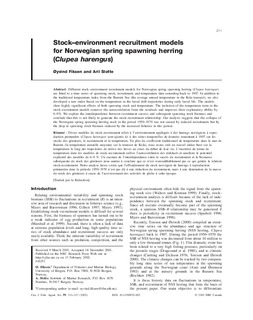| dc.contributor.author | Fiksen, Øyvind | |
| dc.contributor.author | Slotte, Aril | |
| dc.date.accessioned | 2007-06-06T11:44:54Z | |
| dc.date.issued | 2002 | |
| dc.identifier.issn | 0706-652X | |
| dc.identifier.uri | http://hdl.handle.net/11250/108243 | |
| dc.description.abstract | Different stock–environment recruitment models for Norwegian spring spawning herring (Clupea harengus)
are fitted to a time series of spawning stock, recruitment, and temperature data extending back to 1907. In addition to
the traditional temperature index from the Barents Sea (the average annual temperature in the Kola transect), we also
developed a new index based on the temperature in the larval drift trajectories during early larval life. The models
show highly significant effects of both spawning stock and temperature. The inclusion of the temperature term in the
stock–recruitment models removes the autocorrelation from the residuals and improves their explanatory ability by
6–9%. We explore the interdependence between recruitment success and subsequent spawning stock biomass and
conclude that this is not likely to generate the stock–recruitment relationship. Our analysis suggests that the collapse of
the Norwegian spring spawning herring stock in the period 1950–1970 was not caused by reduced recruitment, but by
the drop in spawning stock biomass induced by the increased fisheries in this period. | en |
| dc.format.extent | 852901 bytes | |
| dc.format.mimetype | application/pdf | |
| dc.language.iso | eng | en |
| dc.subject | herring | en |
| dc.subject | sild | en |
| dc.subject | Barents Sea | en |
| dc.subject | cod | en |
| dc.subject | fish stocks | en |
| dc.subject | torsk | |
| dc.subject | fiskebestander | |
| dc.title | Stock–environment recruitment models for Norwegian spring spawning herring (Clupea harengus) | en |
| dc.type | Journal article | en |
| dc.type | Peer reviewed | |
| dc.source.pagenumber | 211-217 | en |
| dc.source.volume | 59 | en |
| dc.source.journal | Canadian Journal of Fisheries and Aquatic Sciences | en |
| dc.source.issue | 2 | |
| dc.identifier.doi | http://dx.doi.org/10.1139/F02-002 | |
